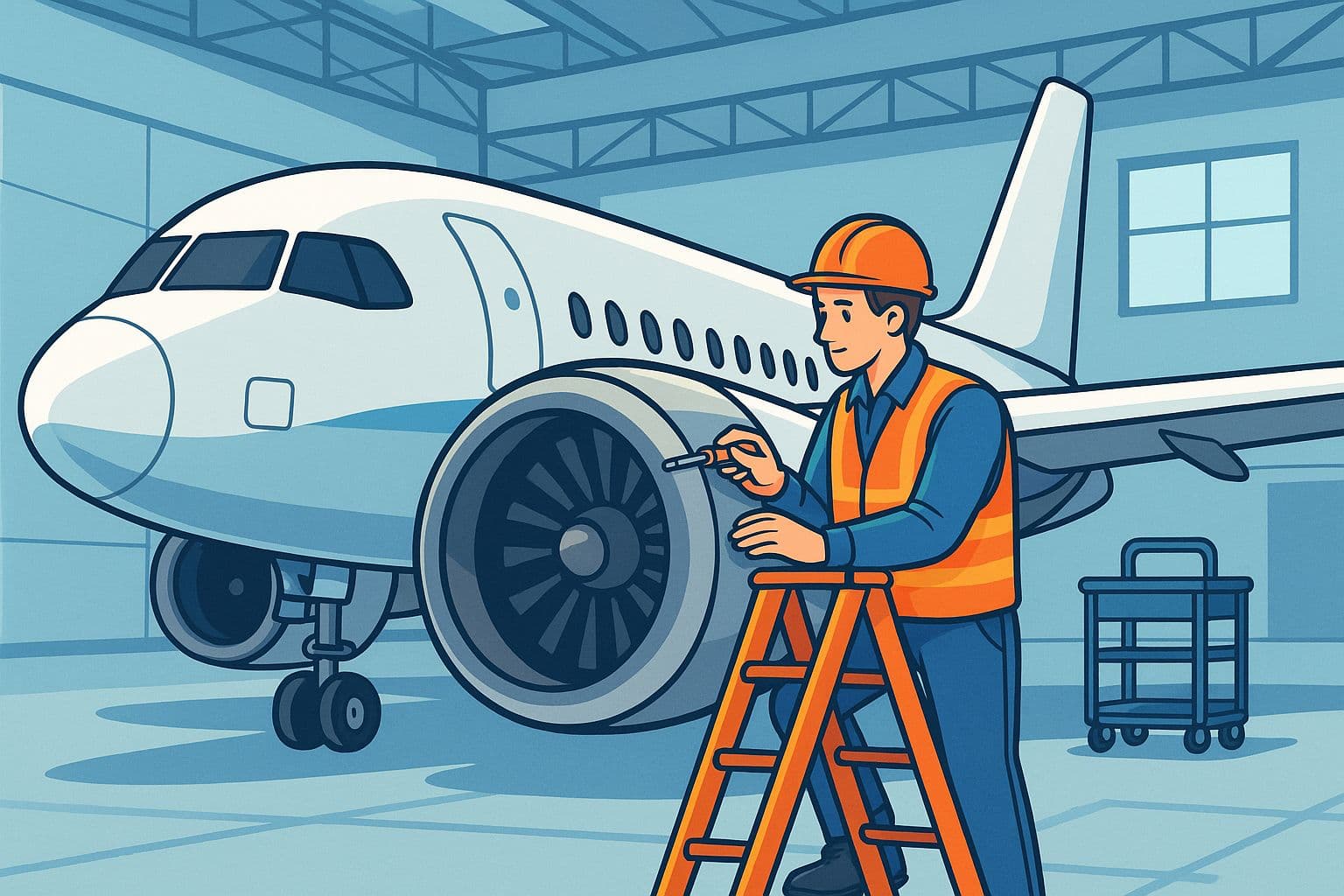Details on Aircraft Maintenance Engineering (AME) Course
The aviation sector is safety-focused, precise, and reliable. The role that safety of air travel relies on most is that of an Aircraft Maintenance Engineer (AME). Aircraft Maintenance Engineers (AMEs) are entrusted with the critical responsibility of validating that an aircraft meets all safety and airworthiness standards before it is cleared for flight. But what is aircraft maintenance engineering? What is the AME course? If you are a student looking for a trade in aviation, knowing the particulars of Aircraft Maintenance Engineering (AME) course will help you find your way to boldly move forward.
This blog will give you everything you need to know about the details of the aircraft maintenance engineering course details, including eligibility, length, potential jobs, and much more! We will cover the AME course full form, the different types of aircraft engineering courses, and what's needed to be a licensed aircraft maintenance engineer. Whether you love aircraft systems or are intrigued by technology in aviation, this will be a useful consolidated guide for you.
What is Aircraft Maintenance Engineering (AME)?
Aircraft Maintenance Engineering (AME) is a specialized field related to the repair, maintenance, and authorization of aircraft. While aeronautical engineers design aircraft, AME professionals are responsible for the technical integrity and the ongoing safety of aircraft systems. AMEs engage in everything from completing the documentation reviews to examine engines (turbojets, turboprops, reciprocating), systems, and flight instruments, and ensure that an aircraft is compliant, at least obeys aviation standards. The AME full form in engineering is Aircraft Maintenance Engineering, and it is vital not just to aviation, but the whole aviation ecosystem.
AMEs aren't just mechanics; they are licensed engineers, who are ultimately responsible to approve an aircraft as airworthy. This kind of authorization allows aircraft to conduct flights which are ultimately cleared by an AME professional before departure. Given the liability and responsibility of this authorization, an AME not only needs a solid education, but they also need precise training and equipment, and knowledge about all aviation maintenance technology for the aircraft which the AME is certifying as airworthy.
AME Full Form and Professional Scope
The AME full form, Aircraft Maintenance Engineering, is completely unique from any other engineering discipline. AME is a profession that pulls concepts from Mechanical, Electrical, and Electronic engineering, making AME one of aviation's most integrated, multipurpose applications.
AMEs can specialize in multiple areas:
- B1 (Mechanical): Focuses on aircraft structure, engine, landing gear and other mechanical systems
- B2 (Avionics): Focuses on navigation systems, communication, radar, and electrical systems
Both streams lead to different job roles but contribute towards the safety and reliability of flight. In the final phase of the AME program, the students will undertake industry training in either Maintenance, Repair, and Overhaul (MRO) companies, or AIRLINES. Whether you become a plane mechanic, a flight engineer, or an aircraft maintenance technician, the foundation is the AME course.
AME Course Details
The AME course is designed to be career-oriented and operates under the accreditation of national aviation regulatory bodies like the Directorate General of Civil Aviation (DGCA). An aircraft maintenance engineer course generally takes two to three years and consists of theory classes with practical training on actual aircraft experience. AME courses consist of structured classroom instruction, practical sessions in workshops, and real-time exposure to aircraft maintenance environments.
AME Course Duration and Structure
Typically, the AME course duration spans 2 to 3 years, segmented into academic semesters or technical modules based on institutional frameworks. Students study aviation regulations, aircraft structures, propulsion systems, avionics, and more. There are two main streams:
- Category B1 (Mechanical): Focuses on airframe, engine, and mechanical systems.
- Category B2 (Avionics): Covers electrical, electronic, and instrument systems.
At the conclusion of the AME program, students will complete industry training within either Maintenance, Repair and Overhaul (MRO) organizations or AIRLINES. This training module allowed the student to apply their knowledge to real world problems, aircraft inspections, troubleshooting, and maintenance activities.
Key Areas of Study Covered
A typical aircraft maintenance engineering course includes:
- Aircraft Propulsion Systems
- Aircraft Electrical and Instrumentation
- Human Factors in Aviation
- Aviation Rules and Regulations
- Aircraft Materials and Hardware
- Maintenance Practices
- Aircraft Systems and Structures
- Aviation Legislation
In-depth knowledge of these subjects helps students perform tasks such as pre-flight checks, major overhauls, and defect rectification.
Mastery of these skills will allow students to perform activities such as pre-flight checks, overhaul and defect rectification.
Entry Requirements
To qualify for a course in aircraft maintenance engineering, candidates must have one of the following:
- Passed 10+2 with Physics, Chemistry and Math (PCM)
- Or a 3-Year diploma in mechanical, electrical or aeronautical engineering.
- Physically fit with normal color vision
Additional requirements may include qualifying in institute-specific entrance exams or aptitude tests. Some institutions may also conduct interviews to assess students' interest in aviation mechanics.
Aircraft Maintenance Technician vs. Aircraft Engineer
An aircraft maintenance technician is an individual who typically provides maintenance to the aircraft systems who are not certified to sign airworthiness releases. While the aircraft maintenance engineer is typically a certifying individual regulated by aviation authorities who are allowed to provide a certified release to service the aircraft.
This distinction is vital. Only licensed AMEs can sign off aircraft for flight. Without their approval, no commercial aircraft can legally take off. This accountability makes the AME a critical stakeholder in aviation operations.
Training Infrastructure and Teaching Methodology
Leading AME colleges in cities such as Chennai and Pune offer state-of-the-art laboratory facilities and access to actual aircraft components to facilitate experiential learning.. These include engines, fuselage sections, avionics panels, and simulation tools. Many colleges also have partnerships with aviation organizations to offer internship opportunities.
Classroom learning includes theoretical subjects based on DGCA modules. Through workshop-based training, students engage in dismantling, diagnosing, and reassembling various aircraft systems to develop core technical competencies. Flight simulation labs allow students to explore the actual runtime behavior of aircraft systems in many different conditions.
Practical training is compulsory. Colleges such as Hindustan Aerospace & Engineering Pune offer on-job training with their airline partners. This stage molds the students as they move from naïve pupils to confident professionals able to face the challenges of airport hangars, MROs, and aviation facilities.
Related Courses in Aviation Engineering
Aspirants may also consider:
- Aeronautical Engineering: Focuses on design and development of aircraft
- Aircraft Engineering: Broader understanding of aircraft systems and mechanics
- Diploma in Aircraft Maintenance Engineering: Shorter programs with focused learning
- Aviation Mechanic Courses: Entry-level skill courses
- Flight Engineer Course: Training on managing in-flight systems
- Aviation Classes and Simulation Programs: For exposure to real-time aviation scenarios
Each course offers unique opportunities, but none replace the certification power of an AME license.
Job Opportunities and Career Scope
With a valid AME license, professionals can pursue a wide range of careers:
- Aircraft Maintenance Engineer (AME)
- Airplane Mechanic or Aircraft Mechanic
- Flight Engineer
- Air Traffic Controller (with further certification)
- Aviation Quality Inspector
- Maintenance Planner
- Aerospace Maintenance Technician
Global demand for AMEs is rising. According to industry trends, airlines are increasing fleet sizes, leading to growing recruitment for aircraft maintenance professionals. Opportunities exist with:
- Commercial Airlines
- Cargo Carriers
- Business Jet Operators
- Government Aviation Wings
- International MRO Facilities
With experience, AMEs can become Lead Engineers, Quality Auditors, Training Instructors, or even set up their own aviation consultancies.
Licensing and Certification Process
In India, the DGCA is the governing body for AME licensing. After completing the AME course, students appear for DGCA’s module exams. Each module focuses on a specific topic such as airframe systems, avionics, and aviation law.
Once all of the required modules have been successfully completed and a reasonable amount of practical experience has been gained, students are awarded the Aircraft Maintenance License (AML) – which gives them the legal qualification to certify that an aircraft is worthy of flying.
There are licensing authorities in other countries:
- EASA (European Union Aviation Safety Agency)
- FAA (Federal Aviation Administration, USA)
- CAAC (Civil Aviation Administration of China)
Indian AMEs with international experience will be able to upgrade their licenses to the international level.
AME Salary Trends
Earnings vary by country, experience, and sector. In India, a fresher AME may start with ₹4–6 LPA. In 5–7 years, it can rise to ₹10–18 LPA. For countries like the USA or UAE, licensed AMEs can earn anywhere from $50,000 to $90,000 per year.
Jobs in defense or government aviation may include primary benefits such as housing, travel, and sometimes pension. In commercial aviation, the major players such as Boeing, Airbus, IndiGo, and Emirates, recruit AMEs on a consistent basis.
Aircraft Maintenance Technology in the Future
Aircraft are becoming increasingly advanced; onboard digital systems and AI-driven diagnostics systems.Future AMEs will need to be skilled in:
- Digital troubleshooting
- Automation systems
- Aviation cybersecurity
- Simulation training
- Composite material handling
Hence, continuous learning is essential. Many institutions offer upgrade training, refresher courses, and international certification paths.
FAQs (Frequently Asked Questions)
1. What is the AME full form in aviation?AME stands for Aircraft Maintenance Engineering – a specialized program for becoming a licensed aircraft maintenance professional.
2. What is the difference between aircraft engineering and AME?Aircraft engineering is broader and design-focused. AME is hands-on and ensures aircraft maintenance and safety.
3. How long is the AME course duration?Typically 2 to 3 years, including both theory and practical training at approved institutions.
4. Can I take AME after 12th grade?Yes, if you have a science stream background (PCM) or a relevant diploma.
5. What is the role of DGCA in AME programs?DGCA regulates and approves AME programs in India, conducts exams, and issues licenses.
6. Is an airplane mechanic course the same as AME?No. An airplane mechanic course may be shorter and not always lead to licensing. AME courses are regulated and license-focused.
7. Are there good job opportunities after AME?Absolutely. You can work with airlines, MROs, airports, and defense organizations globally.
8. What is the full process to become an AME?Enroll in a DGCA-approved course → Pass theoretical exams → Complete practical training → Clear licensing exams → Receive AME License.











